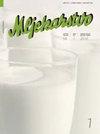The effect of plant extracts on antioxidant potential, microbial and sensory attributes of stirred yoghurt
IF 1.1
4区 农林科学
Q3 AGRICULTURE, DAIRY & ANIMAL SCIENCE
引用次数: 5
Abstract
The aim of this study was to use various plants to increase the functional properties of yoghurt. The ethanol extracts of three different plant (Mentha piperita L., Ocimum basilicum L., and Hibiscus sabdariffa L.) extracts were added to the stirred type yoghurts at different ratios (0.1 %, 0.3 % and 0.5 %). The pH values, colour values, antioxidant activity, microbial and sensory attributes of yoghurt were evaluated on the storage days of 0, 7, 14, 21, and 28. The lowest pH values were found at the beginning (4.29) and at the end (3.95) of the storage period in samples containing 0.5 % hibiscus extract. The addition of plant extracts in amounts of 0.3 % and higher decreased the lightness (L*) value of yoghurt (p<0.05), and the maximum decrease was found in yoghurt samples containing 0.5% hibiscus ethanol extract. The concentrations of added mint and basil extracts increased the yellowness (b*) value (p<0.05), while the addition of hibiscus extract significantly increased the redness value (p<0.05). Hibiscus ethanol extract significantly reduced the growth of total aerobic mesophilic bacteria (TAMB), lactic acid bacteria (LAB) and Lactococcus/Streptococcus bacteria (p<0.05). The antioxidant activity of all samples increased with adding plant extracts. According to the results of sensory analysis, the addition of 0.1 % plant extracts to yoghurts rated higher scores than that of the control sample, but the addition of 0.3 % and 0.5 % ethanol extracts negatively affected the sensory properties. It can be concluded that adding plant extracts had a positive effect on the sensory and functional properties of yoghurt.植物提取物对搅拌酸奶抗氧化能力、微生物和感官特性的影响
本研究的目的是使用各种植物来提高酸奶的功能特性。将三种不同植物(薄荷、罗勒和芙蓉)提取物的乙醇提取物以不同比例(0.1%、0.3%和0.5%)加入搅拌型酸奶中。在0、7、14、21和28的储存日评估酸奶的pH值、颜色值、抗氧化活性、微生物和感官特性。在含有0.5%木槿提取物的样品中,在储存期的开始(4.29)和结束(3.95)发现了最低的pH值。0.3%及以上的植物提取物的添加降低了酸奶的明度(L*)值(p<0.05),并且在含有0.5%木槿乙醇提取物的酸奶样品中发现最大的降低。添加薄荷和罗勒提取物的浓度增加了黄度(b*)值(p<0.05),而添加木槿提取物则显著增加了红度值(p<0.05)。木槿乙醇提取物显著降低了总需氧中温细菌(TAMB)的生长,乳酸菌(LAB)和乳球菌/链球菌(p<0.05)。所有样品的抗氧化活性随着植物提取物的添加而增加。根据感官分析结果,在酸奶中添加0.1%的植物提取物比对照样品得分更高,但添加0.3%和0.5%的乙醇提取物对感官特性产生了负面影响。可以得出结论,添加植物提取物对酸奶的感官和功能特性有积极影响。
本文章由计算机程序翻译,如有差异,请以英文原文为准。
求助全文
约1分钟内获得全文
求助全文
来源期刊

Mljekarstvo
Agricultural and Biological Sciences-Animal Science and Zoology
CiteScore
1.90
自引率
41.70%
发文量
18
审稿时长
12 weeks
期刊介绍:
Mljekarstvo is an open access, peer-reviewed international quarterly scientific journal. The first issue was published in 1951, by the Croatian Dairy Operators'' Association (today: Croatian Dairy Union, publisher). In a paper at a Union conference held 28 October 1951 in Zagreb it was said: "Our desire is that this magazine does not meet the fate of its predecessors, but that it continues to reflect the creative efforts and to provide guidelines for the producers as well as all other operators employed in the dairy industry."
It is our pleasure today to say that wishes of the enthusiasts who attended the conference have come true, and the magazine Mljekarstvo during the last six decades was a reflection of the creative efforts of numerous dairy scientists and experts, and through its texts it served as a guideline in improving production and processing of milk and dairy products. Mljekarstvo has been following all the achievements of the dairy profession in Croatia, and it also gives the short surveys of world achievements. The result of the research of local and foreign scientists and experts always find their place in the magazine Mljekarstvo. It has been edited by our outstanding dairy experts employed at colleges, research institutions and dairy companies.
 求助内容:
求助内容: 应助结果提醒方式:
应助结果提醒方式:


